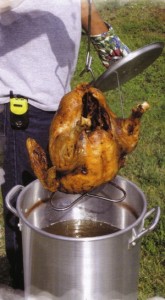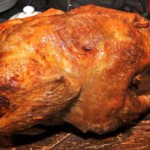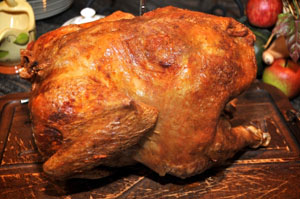By Mike Stines, Ph.B.
Despite the three-day process, it’s well worth the effort to cook turkey this way. Created in the South, this method of cooking a turkey is gaining popularity all across the country. This process produces a succulent turkey and if the oil is at the correct temperature, a crisp, not greasy skin. Turkey fryers—a heavy-duty stand with a high-BTU propane burner—are available from a number of sources at a range of prices. Don’t purchase an inexpensive cooker, as strength and stability are key safety factors when heating oil.
 A few words of caution: deep-frying is cooking with a vat of very hot (350 to 375 degrees F.) oil, so be sure the stand is very sturdy and placed on a level surface away from overhanging branches. Don’t use a turkey fryer on a wooden deck and never leave the fryer unattended. Deep-frying is inherently dangerous. If the oil gets above 450 degrees F., it can spontaneously ignite and most turkey fryers do not have thermostats to control the heat. Because of this, Underwriters Laboratory has declined to certify any turkey fryers because of safety concerns. Make sure your turkey is completely thawed and no liquid comes into contact with the hot grease.
A few words of caution: deep-frying is cooking with a vat of very hot (350 to 375 degrees F.) oil, so be sure the stand is very sturdy and placed on a level surface away from overhanging branches. Don’t use a turkey fryer on a wooden deck and never leave the fryer unattended. Deep-frying is inherently dangerous. If the oil gets above 450 degrees F., it can spontaneously ignite and most turkey fryers do not have thermostats to control the heat. Because of this, Underwriters Laboratory has declined to certify any turkey fryers because of safety concerns. Make sure your turkey is completely thawed and no liquid comes into contact with the hot grease.
For the deep-fried turkey, you’ll need a high BTU outdoor burner, a 26- or 32-quart stockpot with a rack and hanger to lift the turkey, and a deep frying thermometer. The cooker I use is a Bayou Classic, manufactured by Barbour International in Brandon, Mississippi. The 32-quart pot will deep fry a turkey up to 25 pounds while a 26-quart pot is good for a turkey up to 16 pounds.
You’ll also need about 3 gallons of peanut, canola, or sunflower oil. A kitchen syringe, also sold under the brand name of “Cajun Injector,” is also necessary to inject the turkey with the marinade. Most barbecue outlets carry injector kits or they may be ordered over the Internet.
A long-sleeved shirt, long pants, closed-toed shoes, gauntlet-style asbestos gloves, safety glasses, and a dry chemical fire extinguisher are also a good idea. A caveat… never even think about trying to do this in an enclosed area such as a garage or carport unless you want to invite the fire brigade to dinner!
- 1/4 cup coarse kosher salt
- 2 tsp ground bay leaf
- 3 tbsp onion powder
- 1 tbsp ground cayenne pepper
- 3 tbsp freshly ground black pepper
- 2 tsp filé powder (ground sassafras)
- 3 tbsp white pepper
- 3 tbsp granulated garlic
- 2 tbsp dried basil
- 1 1/2 tbsp ground hot Hungarian paprika
- 1/4 cup liquid garlic
- 1/4 cup onion juice
- 2 tbsp liquid crab boil
- 1/4 cup Worcestershire sauce
- 1/4 cup cayenne pepper sauce
- 2 tbsp Cajun Turkey Seasoning see recipe above
- 1/2 cup unsalted butter melted
- 1 gallon cold water
- 2 cups cold water
- 2/3 cup coarse kosher salt
- 2/3 cup dark brown sugar firmly packed
- 1/2 cup cracked black pepper
- 1 tsp dried thyme
- 1 tbsp whole cloves
- 3/4 tbsp cracked allspice
- 3 bay leaves crumbled
- 3/4 tbsp crushed juniper berries
- 1 10-16 lb turkey Try to purchase a turkey that is not already injected with “enhancements.”
- Peanut or canola oil
- Combine all of the ingredients in a small mixing bowl.
- Combine all ingredients in a mixing bowl.
- Combine the 2 cups of water, salt, sugar, and herbs in a medium saucepan and bring to a boil. Reduce the heat and simmer for 10 minutes. Add the mixture to 1 gallon of cold water and cool completely.
- To determine how much oil to use, place the turkey in the stockpot before seasoning and add water until the turkey is just covered. Use a ruler to measure the distance from the top of the pot to the water level. There should be at least 3 inches from the top of the pot to the top of the turkey. Thoroughly dry the pot before filling it with the oil.
- Remove the pop-up thermometer from the turkey if there is one.
- After removing the giblets and neck, brine the turkey overnight or up to 24 hours under refrigeration. Rinse the turkey well with cold water and pat dry. Place the turkey in a large roasting pan and apply the Cajun Turkey Seasoning liberally to the inside and outside of turkey. Using a kitchen syringe, inject turkey with the marinade (1 ounce per pound). Cover the turkey and refrigerate overnight.
- Remove turkey from the refrigerator an hour before cooking to bring it to room temperature. Cut the skin between the leg and the rib cage. Do not truss or tie the legs together. Be sure the turkey is completely dry to prevent the oil from splattering.
- Clip a deep fry thermometer to the side of the stockpot being sure it’s submerged by at least 1 inch of oil. Begin heating the oil. Don’t set the burner to the highest setting, as you may need to increase the heat after you’ve added the turkey. Depending on the amount of heat from the burner, this could take 20 minutes to an hour for the oil to come up to temperature. Do not leave the fryer unattended!
- When the oil reaches 375 degrees F., place the turkey on the rack, neck down and very slowly lower it into the oil. (Always wear gloves and a long-sleeved shirt when doing this. This is best done with 2 people, each holding one side of the hanger. Do not lean over the pot when lowering the turkey.) The oil will bubble quite a bit until the turkey is completely submerged. Check the temperature of the oil; it will drop about 50 degrees when the turkey is lowered into it.
- Adjust the flame so that the oil returns to 350 degrees F. but do not allow it to go above 375 degrees F. For turkeys weighing 12 pounds and under, fry the turkey for 2 ½ minutes per pound plus 5 minutes. For turkeys weighing over 12 pounds, fry for 3 minutes per pound plus 5 minutes.
- When cooked, carefully remove turkey from the oil. (An instant-read thermometer should register 180 degrees F. in the thickest part of the thigh and 170 degrees F. in the breast.) Place the rack on a small stack of newspapers or paper bags for a few minutes to drain.
- Remove the turkey from the rack and place on a serving platter. Allow the turkey to rest for 20 to 30 minutes before carving. Chef’s note: The oil may be reused and will cook 4 or 5 turkeys before beginning to break down. Either strain the cooled oil and reuse it later or invite your neighbors over to use your cooker!







